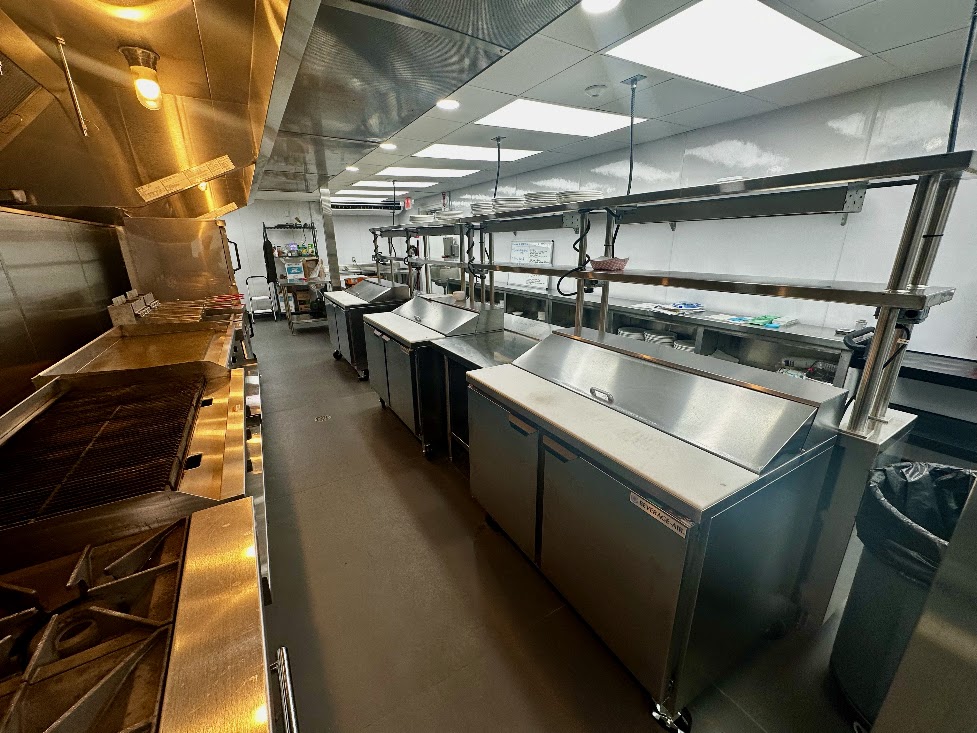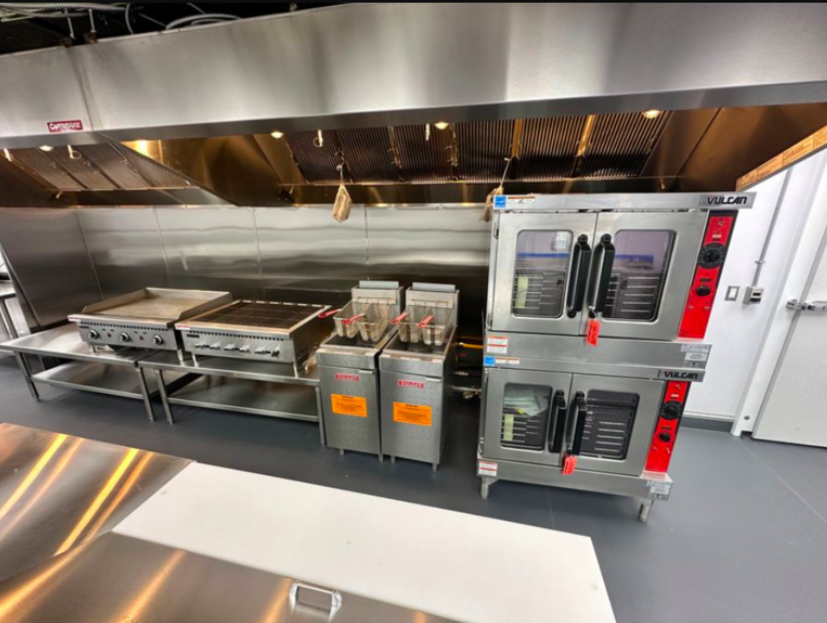The commercial kitchen design landscape is evolving faster than ever. In 2025, efficiency, sustainability, and smart technology aren’t just design trends, they are business-critical imperatives. For restaurateurs, caterers, and hospitality businesses, adapting to these shifts is essential to stay competitive, compliant, and profitable.
Industry data underscores this transformation: roughly 73% of restaurant operators are increasing technology investments, and 45% report workforce challenges that technology is helping to address.
Outdated kitchen designs lead to higher energy and labor costs, inefficiencies, and potential safety risks. In contrast, adopting energy-efficient layouts, modular kitchen solutions, and advanced automation can streamline workflows, reduce expenses, and elevate the dining experience.
In this blog, we’ll explore the top commercial kitchen design trends shaping 2025 and beyond, such as smart automation, modular construction, and advanced sanitation technologies, offering insights into how hospitality businesses can future-proof their kitchens for peak performance, regulatory compliance, and customer satisfaction.
A well-designed commercial kitchen does far more than look good, it’s a core driver of operational efficiency, regulatory compliance, cost control, and customer satisfaction. As the foodservice industry faces rising labor costs, tighter health regulations, and growing demands for sustainability, staying ahead of design trends is essential for long-term success.
Modern kitchen design focuses on maximizing output while minimizing costs and resource waste. Innovations like modular layouts, energy-efficient equipment, and automated workflows help businesses adapt to these pressures, ensuring streamlined operations that meet FDA and EPA compliance standards.
Beyond the back-of-house, kitchen design also directly impacts the customer experience. Efficient layouts reduce service delays, enhance food consistency, and enable engaging open kitchen concepts that build transparency and trust with guests.
In today’s competitive landscape, your kitchen isn’t just a workspace, it’s a strategic asset. Businesses that embrace cutting-edge design trends gain a competitive edge through faster service, lower overhead, improved compliance, and a stronger brand reputation. Falling behind, however, risks inefficiency, regulatory penalties, and lost growth opportunities.

Automation is rapidly becoming the backbone of modern commercial kitchens. Connected kitchen systems streamline workflows, reduce manual tasks, and enhance operational visibility. Automated systems can:
A prime example is Welbilt’s KitchenConnect, an award-winning cloud-based platform that connects restaurant equipment to improve efficiency, reduce downtime, and ensure consistent food quality. As automation becomes more accessible, connected kitchens are set to become standard practice across the industry.
Robotics in commercial kitchens are no longer a futuristic concept, they’re here. Robots are being deployed for tasks like:
Advanced AI-driven robots can adapt to ingredients, follow custom recipes, and maintain precision, freeing human staff to focus on creative, customer-facing tasks.
ContekPro partnered with Picnic, a leading provider of automated pizza makelines, to develop the first modular automated pizza kitchen, combining robotics and modular construction for unparalleled efficiency and scalability.

Post-pandemic hygiene standards have transformed sanitation into a critical design element. In 2025, kitchens are adopting:
These technologies not only enhance food safety but also improve compliance with increasingly strict health regulations. Operators investing in advanced sanitation systems can differentiate themselves by offering visibly safer, more hygienic environments.
Labor shortages have made employee comfort and well-being a top priority. Ergonomic kitchen designs improve efficiency and retention by:
Human-centric design not only reduces staff injuries but also fosters a more productive and satisfied workforce.
%20(1).jpg)
Sustainability efforts are extending beyond energy to encompass water usage and waste management. In 2025, more kitchens are implementing:
Closed-loop water systems drastically cut consumption, reduce operational costs, and position businesses as environmental leaders. These innovations are particularly important in regions facing water scarcity.
Effective ventilation is critical for maintaining a safe, comfortable, and energy-efficient kitchen environment. Modern systems go beyond basic exhaust; they are designed to:
For high-end, heavy-duty kitchen models, ContekPro integrates the Paragon RTU by CaptiveAire, a cutting-edge HVAC solution that offers exceptional energy savings, precise humidity control, and superior air comfort.
.jpeg)
Energy efficiency remains a top priority for commercial kitchens in 2025. Operators are focusing on:
These strategies not only cut operational costs but also support sustainability goals. At ContekPro, our modular kitchen designs are engineered for energy efficiency, helping clients reduce their environmental footprint and energy bills.
Modular construction is rapidly emerging as the preferred method for commercial kitchen builds. By prefabricating kitchen units in a factory-controlled environment, businesses benefit from:
At ContekPro, we specialize in prefabricated modular kitchens ranging from 160 sq. ft. to over 6000 sq. ft., with prices starting from $100,000. Our modular solutions allow foodservice operators to save time, reduce costs, and simplify the entire construction process.
Hybrid kitchen models are redefining how restaurants utilize their kitchen spaces. By integrating ghost kitchen operations within existing physical locations, businesses can maximize kitchen output while expanding into the booming online ordering and delivery market.
Hybrid kitchens allow operators to:
This dual-purpose approach increases productivity and revenue streams without significant capital expenditures. For restaurants facing rising real estate and labor costs, hybrid kitchen models offer a scalable, cost-effective solution that aligns perfectly with the flexibility and modularity of 2025’s kitchen design trends.
.jpeg)
Designing a high-performance commercial kitchen in 2025 requires more than following trends, it demands a strategic partner who can turn those trends into practical, cost-effective kitchen solutions.
At ContekPro, we specialize in prefabricated modular commercial kitchens built to meet the evolving needs of foodservice businesses. Our modular approach allows you to:
Whether you’re opening a new restaurant, expanding a commissary, or upgrading a hotel kitchen, ContekPro delivers turnkey modular kitchen solutions that align with modern design trends while simplifying every step of the process.

The commercial kitchen landscape is evolving fast. Businesses that move quickly to adopt efficient, flexible, and sustainable kitchen designs will secure a competitive advantage. ContekPro helps you stay ahead with modular kitchens that are built for performance, built for compliance, and built for growth.
Explore our modular kitchen models and see how we can help you transform your kitchen into a high-performance asset ready for 2025 and beyond. Contact us today!
The top commercial kitchen design trends in 2025 emphasize smart automation technologies, robotics for routine kitchen tasks, advanced sanitation systems, ergonomic workspaces, and a strong focus on energy-efficient and modular kitchen construction. These design innovations help businesses boost operational efficiency, cut overhead costs, meet strict compliance standards, and stay flexible in a fast-changing foodservice landscape.
Modular kitchen construction allows restaurants and food businesses to reduce build times, control construction costs, and maintain flexibility for future growth. Prefabricated in a factory setting, modular kitchens are designed for quick deployment, scalability, and compliance with health and safety standards, making them a practical solution for both permanent and temporary kitchen setups.
Energy-efficient kitchen designs focus on using Energy Star-rated appliances, insulated structures, optimized ventilation systems, and water-saving fixtures. These elements reduce energy consumption, lower utility bills, and support sustainability goals, all while maintaining high-performance standards in food production.